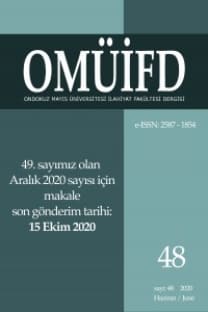İslâm Estetiği
Müslüman toplulukların oluşturmuş olduğu İslâm sanatı, günümüze kadar geniş bir coğrafyada üretilmiş sanat eserlerinin tümünü ifade etmektedir. İslâm sanatı, insan hayatını tüm yönleriyle yüceltmeyi amaç edinmekle birlikte, insana hakikati hatırlatıcı ve estetik düzeyde onu gözlemleyebilme yetisine kavuşturmaya yardımcı niteliktedir. İslâm medeniyetinde teşekkül etmiş eserlerdeki temel amaç, nesnenin mükemmel biçime ulaştırılmasıdır. İslâmî estetik anlayışının özü tevhid ve tenzih ilkesine dayanmaktadır. Müslüman sanatçılar bu ilkelerin korunması adına soyutlamaya yönelmiştir. İslâm sanatında güzellik algısı üzerinde durulmuş ve güzellikle hakikat, bilgi, iyilik, yararlılık gibi kavramlar arasındaki ilişki irdelenmiştir. Güzellik ve estetik tecrübenin açılımlarından bahsedilirken güzelliğin gerçekliği, sanatsal yaratım süreci ve felsefe, kelam ve tasavvuf vecihlerinden mahiyeti açıklanmıştır.
Anahtar Kelimeler:
İslâm Sanatı, İslâm Estetiği, Tevhid, Tenzih.
Islamic Aesthetics (Turan Koç, İsam Yayınları, Ankara 2018, s. 222.)
The Islamic art created by Muslim communities represents all the works of art produced in a vast geography until today. As much as it aims to elevate human life in all aspects, Islamic art is also a reminder of the truth, and helps to gain the ability to observe it on an esthetic level. The main purpose of the works that have been composed in the Islamic civilization is to deliver the object to the perfect form. The essence of Islamic esthetics is based on the principle of tawhid and tanzih. Muslim artists have preferred abstraction to protect the principle. In the Islamic art, the perception of beauty has been emphasized and the relationship between beauty and concepts such as truth, knowledge, goodness, usefulness has been under discussion. The implications of beauty and esthetics experience have been explicated with reference to the reality of beauty, the process of artistic creation and the nature of philosophy, theology and Sufism.
Keywords:
Islamic Art, Islamic aesthetics, Tawhid, Tanzih.,
___
- Koç, Turan. İslam Estetiği. Ankara: İsam Yayınları, 2018.
- Yayın Aralığı: Yılda 2 Sayı
- Başlangıç: 1986
- Yayıncı: ONDOKUZ MAYIS ÜNİVERSİTESİ
Sayıdaki Diğer Makaleler
Marx’ın Kapital’i için Okuma Kılavuzu
Descartes’ta Tanrı Fikri ve Tanrı’nın Varlığı
Kur’an ve Sünnet Bağlamında Müslümanın Öteki ile Komşuluğu
İslam Hukuk Düşüncesinde Parça-Bütün İlişkisi
Din ve Felsefenin Kapsam ve Sınırlılıkları Üzerine Bir Değerlendirme
Temmâm Hassân’ın Nevâsıh Fiilleri ile İlgili Görüşlerinin Değerlendirmesi
İbnü’l-Cevzî’nin (Ö. 597/1201) Yâkûte Adlı Eserinin Belâgat Açısından İncelenmesi
